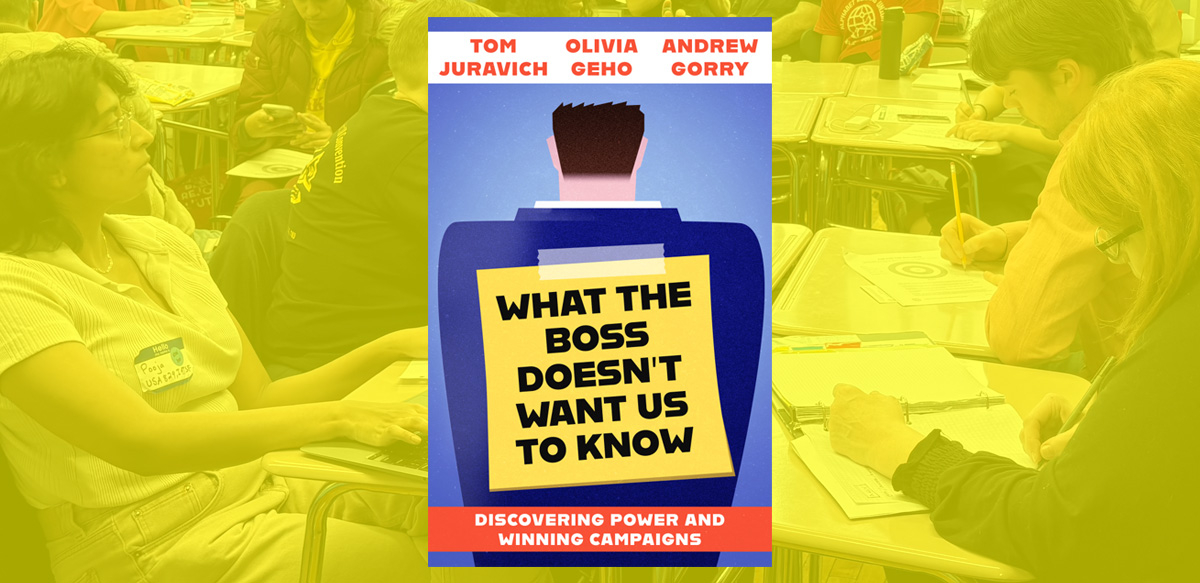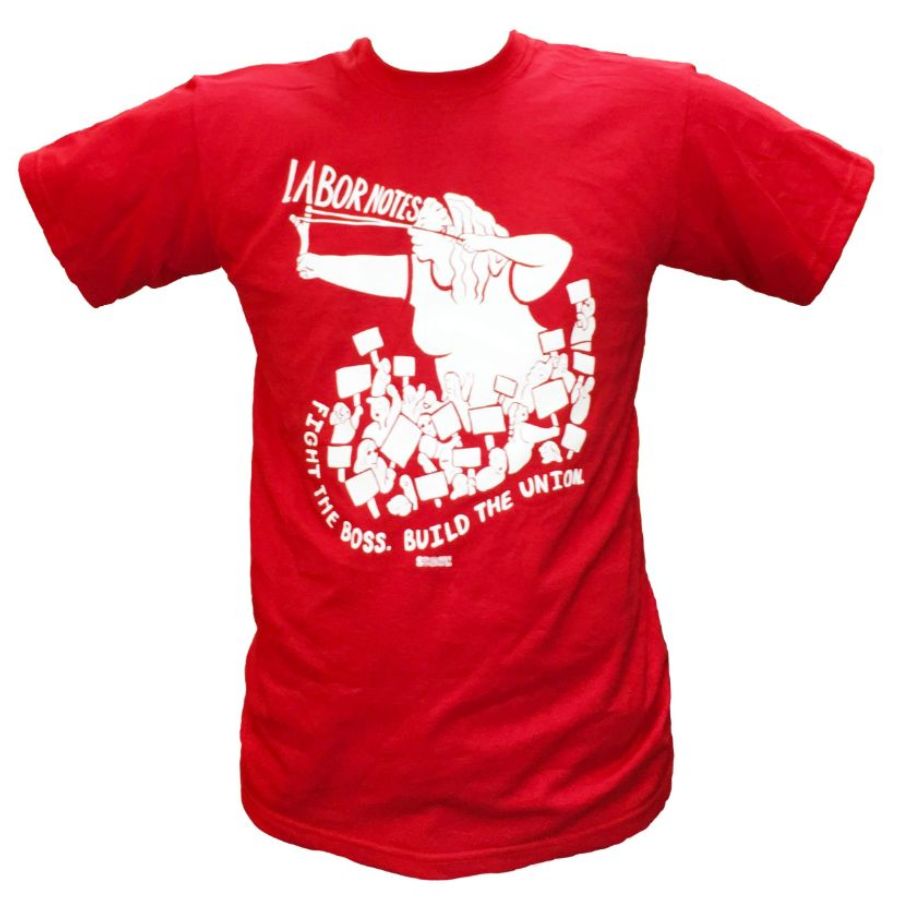Uncover How Your Employer’s Power Flows

A new book teaches how a team of workers can research their employer and design a strategic campaigns based on what they’ve learned.
Review of What the Boss Doesn’t Want Us to Know: Discovering Power and Winning Campaigns by Tom Juravich, Olivia Geho, and Andrew Gorry (PM Press, 2025)
When workers at one company started researching their employer, says a union leader in What the Boss Doesn’t Want Us to Know, “it felt like the curtain was pulled back on Oz. All these things that didn’t make sense to them for so long suddenly made sense.”
In their new book, Juravich, Geho, and Gorry share their experience researching private-sector employers and helping unions design strategic campaigns based on what they’ve learned. Then they teach us how to do it. The audience is not just union leaders or staff, but rank and filers who want to build winning workplace campaigns. Most of the information is geared toward the U.S., but there is solid advice for Canadians, too.
While many unions do corporate research to design organizing or contract campaigns, it’s usually just a staff project. The members, and even local leaders, are expected to take marching orders from the staff team.
This approach is backwards, write the authors. Their model involves members in the research right from the start, all the way through to designing the campaign and adjusting it as events unfold.
Why do it their way? First, workers already have many pieces of the research puzzle, and they’re well-positioned to glean more by observation and conversation with co-workers, customers, and delivery workers. More importantly, when workers design a campaign based on the information they’ve uncovered, they are more likely to throw themselves into making it work.
ZOOM AND GOOGLE DOCS
The authors were advising several unions on strategic campaigns when Covid hit. They had intended to visit the worksites involved, but the pandemic shut down that plan. So they moved to Zoom meetings and shared Google docs—and learned that these tools made them able to more fully integrate workers into the research. Their examples include journalists, grocery workers, flight attendants, and tech workers.
The authors draw on that experience here. The book outlines a six-week plan for doing research and creating a campaign. (They caution that a longer research commitment risks losing people.) They suggest assembling a team of 8-10 workers, ideally from different departments, shifts, and demographics.
The research project needs someone to coordinate it—a staffer or steward, perhaps—who will encourage full participation and who has the research chops to help people when they get stuck. Starting out with first-hand worker knowledge, and entering it into the shared document together, can give workers confidence to proceed to the more daunting parts of the project.
The book’s lead author, Tom Juravich, has long maintained the website StrategicCorporateResearch.org, which acts as a companion to the book. The website and book focus on 24 questions to answer about a firm, covering its leadership, history, strategy, leadership, finances, board, customers, competitors, and more.
Googling a big company can drown you in information. The book and website guide activists away from the chaos of general searches and towards finding bite-sized chunks that can be collected and digested collaboratively. Would-be researchers should use primary sources where possible.
At each meeting, members of the research team present what they’ve found and get assignments for the next round. By the sixth meeting, it’s time to develop a plan.
DON’T AVOID FINANCES
Even some professional union researchers avoid analyzing a company’s finances, say the authors. It’s no wonder: A firm’s financial particulars can be daunting, even without getting into the subsidiaries and parent companies. And an increasing number of us are employed at firms with opaque private equity owners.
At the University of Massachusetts, Juravich has taught generations of union activists how to wade into financial statements and come out with usable information (disclosure: I am one of them). Using a step-by-step approach, you can identify a firm’s profit centers. This type of research informed the Auto Workers’ Stand Up strike in 2023: Union researchers figured out that after-market parts and accessories are hugely profitable for the Big Three. So the union struck parts depots strategically, along with big plants.
Similarly, you might think ticket sales are the profit center for Delta Airlines. In fact, deals with credit card companies have outsized importance for Delta and other big U.S. airlines.
Determining where your employer plans to grow can also open up campaign possibilities. Firms under capitalism have to grow or die, so hampering your employer’s ability to execute its growth plan can be a powerful lever. But first you have to find out what it is.
The book’s companion website has useful links to databases of companies, both those traded on the stock market and privately-held firms where there is less public information available.
LOOK FOR POWER
Research needs to analyze power and how it flows through the corporation, the authors stress. Finding the pressure points in that power structure is generally more effective than denting the brand, especially for companies that don’t care much about their image.
While the stereotypical strategic corporate campaign focuses on actors outside the workplace—board members, customers, suppliers, lenders, shareholders—in fact the research can lead straight back to more effective workplace action, as in the UAW’s Stand Up strike.
Workers have their most concentrated power in the workplace, and the authors acknowledge there are pitfalls to strategic campaigns that exclusively focus elsewhere.

SUPPORT LABOR NOTES
BECOME A MONTHLY DONOR
Give $10 a month or more and get our "Fight the Boss, Build the Union" T-shirt.
They quote the late Jane McAlevey, who argued that strategic campaigns run by staff have worsened undemocratic tendencies in unions. Starting in the 1990s, parts of the Service Employees (SEIU) stopped focusing on workplace-based organizing campaigns altogether, and instead raked in new members by making deals with nursing home corporations. In the process, they traded away workers’ right to strike without workers’ input or even knowledge. Inevitably, the union’s presence in those workplaces was nominal and the contracts barely discernible.
By contrast, the authors’ participatory research model works with, and in some cases leads back to, shop-floor action. “Labor actions that aren’t based on the desires and power of the workers will lack the muscle to win—every time,” they write.
COME FROM MANY DIRECTIONS
The book stresses that we should design campaigns that come from several angles, have a plan to escalate, and be able to flex when something isn’t working.
The element of surprise is important. Employers have hardened themselves against many tactics, such as those pioneered by Ray Rogers during the late 1970s. (Rogers led a successful four-year campaign against textile giant J.P. Stevens in North Carolina that pressured board members, banks, and insurance companies.)
Always go outside what the company expects, the authors advise. The same strategy won’t necessarily work at a different company, or even again at the same company.
HARD ROADS AHEAD
Several times the authors refer to the struggle at A. E. Staley, a corn processing plant in Decatur, Illinois, in the early 1990s, arguing that locked-out workers there were too focused on the workplace, erroneously hoping to win without expansive tactics.
But the Staley example actually shows the difficulty of winning even with a multi-pronged strategic corporate campaign. Early on, Staley workers brought in two important strategic minds: Rogers and Jerry Tucker of the UAW. Tucker, an expert on in-plant strategies, coached the 700 workers through a nine-month work-to-rule campaign, while Rogers designed a pressure campaign against board members and funders.
When Staley locked the workers out in 1993, Tucker, Rogers, and the membership debated the next steps. Rogers believed campaigns to scare off investors were the best angle—the union had already been campaigning against State Farm Insurance. But Tucker and many members favored the easier-to-explain route of getting customers like Miller Beer and Pepsi to stop buying corn syrup from Staley.
A hard-fought and complex campaign against Miller eventually succeeded in reducing Staley’s sales by 10 percent. However, higher-ups in the union pulled the plug on the Pepsi campaign as it gained momentum.
As the authors acknowledge, the Staley workforce was dedicated and united. Staley “road warriors” took their struggle to communities across the U.S., raising millions to support locked-out families. Dozens of solidarity committees across the country put muscle behind campaigns to pressure State Farm, Pepsi, Miller, and other targets. A merger with the Paperworkers (UPIU), a bigger but less militant union, did undermine the struggle. But it’s wrong to say, as the authors do, that the campaign relied on picketing outside the plant.
It can’t be that something only qualifies as a strategic corporate campaign when it wins. The authors here fall into a trap that many other labor writers are also guilty of: trying to claim that only wins fit their model, while excluding losses. Unfortunately, even doing brilliant research and waging a wide-ranging strategic campaign does not guarantee a win.
The eventual loss at Staley nonetheless taught a generation of unionists about the nature of corporate power. Despite the authors’ dismissal of the local’s strategy, Staley, the 2009 book by Steven Ashby and C.J. Hawking, is a worthy companion to What the Boss Doesn’t Want Us to Know.
This raises a point that the authors only hint at: Digging into how your employer operates can be an excellent crash course in how capitalism works. Workers face oceans of pro-corporate propaganda. Coming to grips with the realities that shape our lives can enable us to not only devise effective tactics and strategies, but also begin to plan a political program to create an economy that works for workers.
One place to start is by doing corporate research ourselves—with the aid of this book and accompanying website—workplace by workplace.






